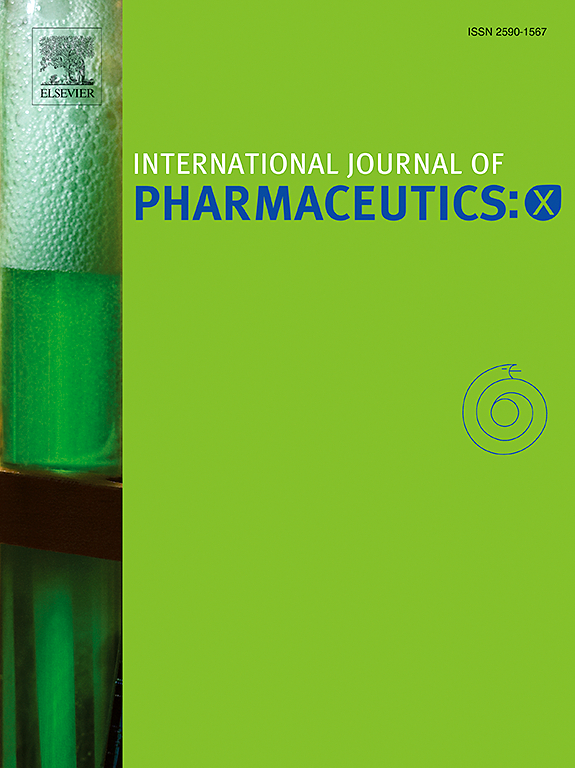Non-destructive quantification of low colchicine concentrations in commercially available tablets using transmission raman spectroscopy with partial least squares
IF 6.4
2区 医学
Q1 PHARMACOLOGY & PHARMACY
引用次数: 0
Abstract
The narrow therapeutic index and significant toxicity of colchicine (COL) underscore the importance of content uniformity of dosage units to ensure drug safety and efficacy. In this study, transmission Raman spectroscopy (TRS) technology combined with partial least squares (PLS) regression was used for the non-destructive determination of low concentration levels of COL in commercial tablets (0.83 % w/w). Based on a multifactor orthogonal design of experiment, one hundred calibration tablets ranging in drug content from 70 % to 130 % of the label claim were manufactured to develop an initial model which was further calibrated using the HPLC results. The quantitative model displayed good repeatability and high accuracy with a root-mean-standard error for calibration of 0.038 % and root-mean-standard error for cross-validation of 0.039 %. The limits of detection and quantification were 0.13 % and 0.40 % w/w, respectively. The absolute value of relative error of the TRS and HPLC content results for commercial tablets varied between 0 and 3.8 %. Notably, the relative standard deviation (RSD) of the TRS method was 1.2 %, lower than the RSD of 2.9 % observed with HPLC. The results demonstrated a fast and non-destructive method for the quality control of highly toxic and low content active pharmaceutical ingredients in commercial products, without human or environmental exposure to toxic substances during sample preparation.

用偏最小二乘透射拉曼光谱法无损定量市售片剂中秋水仙碱浓度
秋水仙碱(COL)治疗指标窄,毒性大,强调了剂量单位含量均匀性对保证药物安全性和有效性的重要性。本研究采用透射拉曼光谱(TRS)技术结合偏最小二乘(PLS)回归,对商品片剂中低浓度COL (0.83% w/w)进行无损检测。采用多因素正交试验设计,制备了100片标配片,标配片的含量范围为标签含量的70% ~ 130%,建立了标配片的初始模型,并利用HPLC结果进行了进一步的标配。定量模型重复性好,准确度高,标定均方根标准误差为0.038%,交叉验证均方根标准误差为0.039%。检测限和定量限分别为0.13%和0.40% w/w。市售片剂TRS和HPLC含量结果的相对误差绝对值在0 ~ 3.8%之间。值得注意的是,TRS法的相对标准偏差(RSD)为1.2%,低于HPLC法的相对标准偏差(RSD) 2.9%。结果证明了一种快速、无损的方法,可用于商业产品中高毒性和低含量活性药物成分的质量控制,在样品制备过程中不需要人类或环境接触有毒物质。
本文章由计算机程序翻译,如有差异,请以英文原文为准。
求助全文
约1分钟内获得全文
求助全文
来源期刊

International Journal of Pharmaceutics: X
Pharmacology, Toxicology and Pharmaceutics-Pharmaceutical Science
CiteScore
6.60
自引率
0.00%
发文量
32
审稿时长
24 days
期刊介绍:
International Journal of Pharmaceutics: X offers authors with high-quality research who want to publish in a gold open access journal the opportunity to make their work immediately, permanently, and freely accessible.
International Journal of Pharmaceutics: X authors will pay an article publishing charge (APC), have a choice of license options, and retain copyright. Please check the APC here. The journal is indexed in SCOPUS, PUBMED, PMC and DOAJ.
The International Journal of Pharmaceutics is the second most cited journal in the "Pharmacy & Pharmacology" category out of 358 journals, being the true home for pharmaceutical scientists concerned with the physical, chemical and biological properties of devices and delivery systems for drugs, vaccines and biologicals, including their design, manufacture and evaluation. This includes evaluation of the properties of drugs, excipients such as surfactants and polymers and novel materials. The journal has special sections on pharmaceutical nanotechnology and personalized medicines, and publishes research papers, reviews, commentaries and letters to the editor as well as special issues.
 求助内容:
求助内容: 应助结果提醒方式:
应助结果提醒方式:


